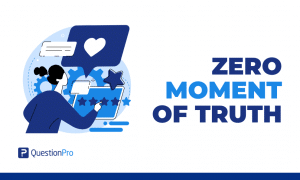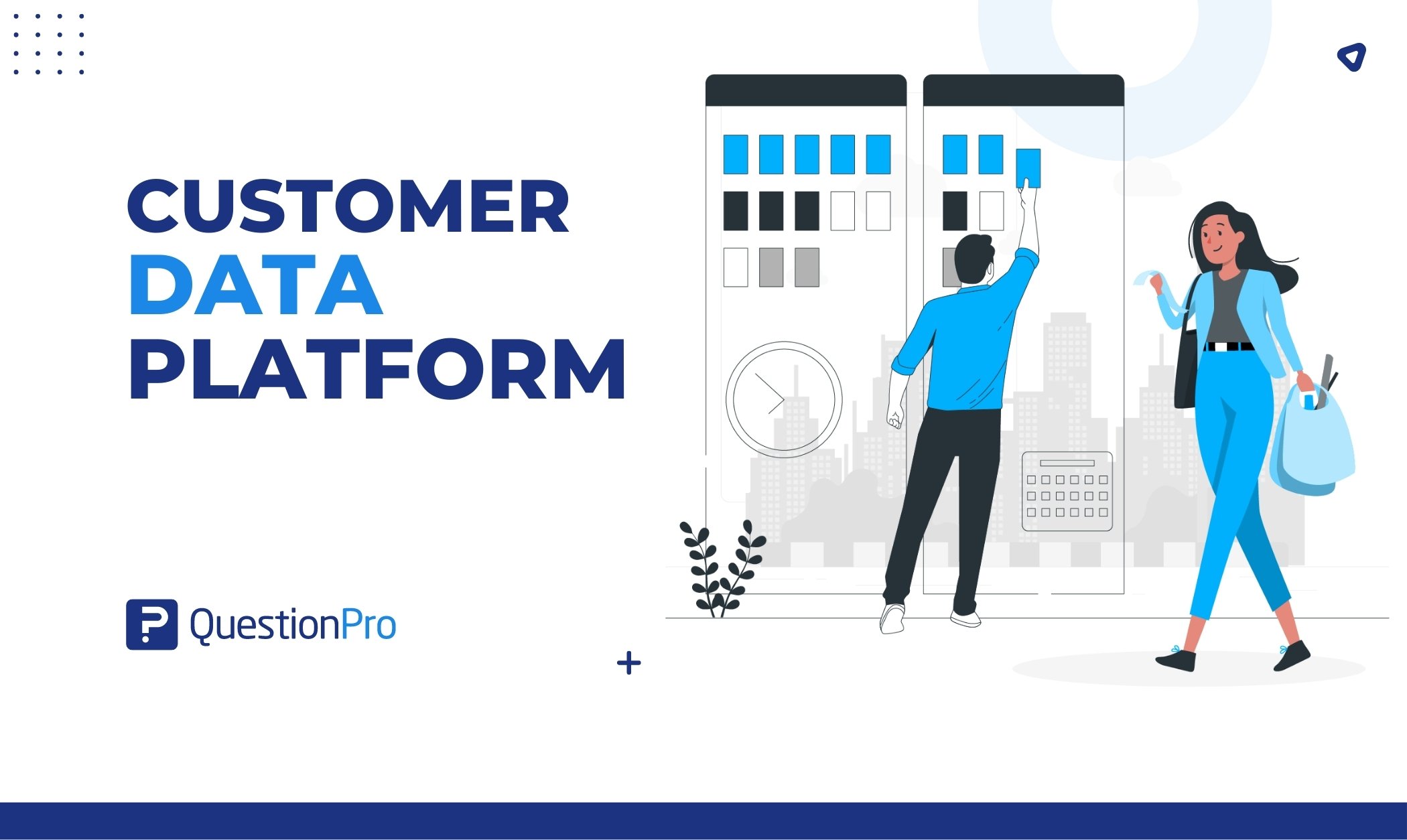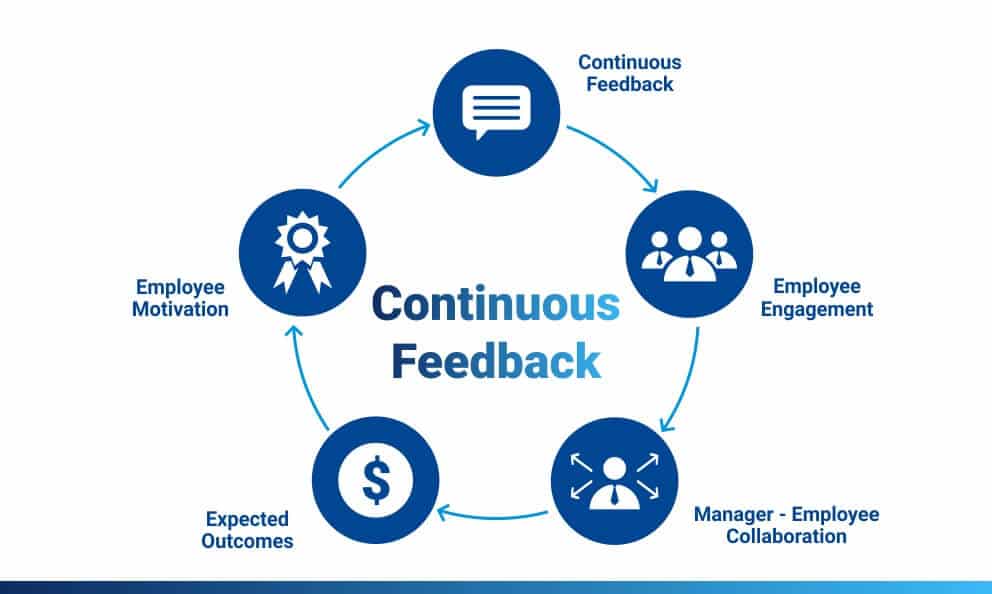
We know that workers desire continuous feedback but don’t always get it. “Don’t just criticize, condemn or complain, give constructive feedback instead”- Dale Carnegie
Giving feedback and checking in regularly is important but not enough. These kinds of talks won’t work if employees don’t understand how they relate to business goals and their own job growth.
“The main thing to take away from this is that most people aren’t getting the job done with the tools and methods they have now,” our study says. “It’s not surprising that only 39% of employees say their current check-ins are working well for them.”
Let’s talk about how continuous feedback differs from traditional feedback models, how it can help your company, and how you can put one in place well.
What is continuous feedback?
Continuous Feedback is defined as a mechanism or a process where an employee receives ongoing employee feedback and is guided in a systematic manner by openly discussing the strengths and weaknesses of the employee.
Human capital is an asset to any organization, and this asset should be taken care of. Thus, organizations need a mechanism where the employees are made aware of what they are doing well and the scope of improvement to be able to perform their tasks well.
For example, let us consider hypothetically you run an organization that has ten thousand employees working in different geographic areas. Let’s consider you take the cognizance to fly down to the different locations and give employees the feedback you wish to give them, but this is just a one-time action. What next?
The motive of feedback is it should be continuous. Therefore, it is essential for organizations to make continuous feedback a regular practice. Feedback is a cyclic process and not a linear process. The cycle makes sure that the content is absorbed, implemented, and repeated.
This process is not only restricted to the corporate world but is also highly appreciated in the field of sports. Athletes are open to the continuous feedback system, and why not?
Each time they are on the field, it is a new challenge for them, but they remember their previous challenges and the winning tactics they applied. Thus continuous feedback in sports is quite evident.
Learn more: Top 20 Employee Engagement Survey Questions
Importance of continuous feedback
Continuous feedback can help your company know what’s happening with your employees. Managers have a better idea of how their workers are doing, and employees don’t have to wait up to a year to find out what they’re doing well and what they can improve on.
In fact, workers are eager to hear how they are doing so they can improve.
This ongoing process can help people talk to each other better, understand their jobs and goals, do their jobs better, and be happier at work. With these gains, companies can reach their lofty goals and improve engagement and retention at the same time.
Continuous feedback can help your business in three important ways.
Boost employee engagement and retention
Continuous feedback improves manager-employee relationships, reducing attrition and hiring expenses.
Good managers motivate and retain workers. Managers influence team engagement by 70%, according to Gallup. Managers have the greatest impact on employee well-being.
Manager support increases employee engagement and loyalty to the company. Managers who help workers construct a professional development plan demonstrate the company’s commitment to their future. A new hire may fail without help.
However, a person who receives ongoing, continuous feedback feels supported and can grow and succeed.
Provide real-time insights
Continuous feedback means no one has to wait until an annual review to give negative feedback or raise vital questions. One-on-one check-ins allow staff to act on feedback promptly. Managers can also help employees with barriers.
This prevents errors from accumulating. Real-time feedback can help lessen recency bias, which occurs when managers only consider an employee’s most recent performance. Frequent check-ins help managers understand employees as workers and people.
These dialogues and goals can also assist HR leaders in assessing the company’s performance and deficiencies.
Promote employee development
Continuous feedback lets employees know what they’re doing well, what they can improve, and what possibilities await them. These workers are comfortable asking for support or stretch tasks from management.
If a salesman can’t persuade a promising prospect to return calls and emails, they can seek their management for advice at their next check-in.
HR directors may utilize these insights to build learning and development paths that assist these people’s progress while fulfilling essential business objectives, such as missing skills the organization will need in the future.
Continuous feedback model and system
The continuous feedback model is also known as the Deming wheel, as renowned management consultant Dr. Edwards Deming developed it in the 1950s. The model is based on four attributes:
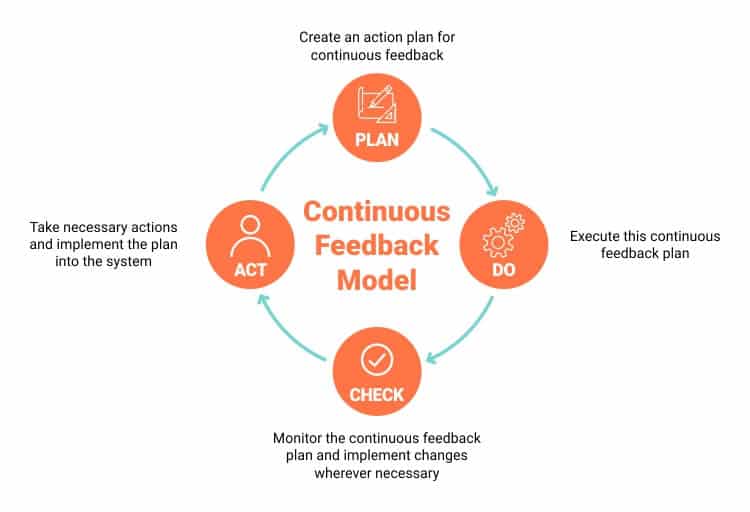
1. Plan:
You need to identify and understand where the problem lies even before you plan to give feedback to the employees. Your feedback must be based on facts and statistics and not on your memory of the past experiences you might have had with the employee(s). You must first explore information, define your feedback, generate ideas to deliver the feedback, and then implement the feedback.
2. Do:
Once you have identified the strengths and weaknesses of the employees, it’s time first to check the system with a small-scale pilot project before you implement the system in the entire organization. This will allow you to assess whether your proposed changes have achieved the desired outcome with minimum disruption.
3. Check:
You analyze the pilot project’s results at this stage against your defined expectations. If the employee expectations are in tandem with reality, then it’s time to implement the plan. Move to the final phase of implementation only when you are completely satisfied with the results.
4. Act:
This is the stage where you implement the process. Remember, this is a continuous process, a loop, and not a linear process with a beginning and an end. This means your improved process now becomes a stepping stone to keep improving the process for your employees at equal intervals.
Learn more: 30 Employee Satisfaction Questions That You Can’t Afford to Miss!
Continuous feedback performance management
According to a study carried out by Forbes, nearly 75% of employees consider feedback important, but less than one-third receive it. This is the era of technology, and change is the only constant here. Human resources and how they have operated for the last decade have witnessed a 360-degree feedback change.
This change has been implemented because employees are no longer interested in the annual reviews, they want continuous feedback, and they want it now. Therefore, organizations need to change the whole system of how and when employees receive their feedback.
In this technology-driven world, organizations must be attentive to focus more on processes and programs designed to attract talent and retain them. Employee attrition has been an issue organizations have dealt with for a long time. Continuous feedback is the answer to increased employee engagement.
Let us look at this mechanism from an employee’s perspective. Imagine you are wearing a fitness device, and your device gives you your step count at the end of the year and not daily. You would have no reasons to change your diet plan or exercise routine, and the results you are willing to obtain will be a far-flung dream.
Unsurprisingly, employees feel the need for timely employee feedback and due recognition. It is an attribute requiring them to perform better at work. They see this as an opportunity to take their career in the right direction.
Rolling out a continuous feedback performance management system program allows organizations to give employees what they really want so that employees can leverage ongoing feedback.
Here are the actions that HR leaders across the globe are taking to implement continuous feedback performance management:
1. Don’t make it a scary process:
It’s simple science, a human brain is hypersensitive to anything it thinks is a threat. In organizations where employees are scared of admitting their mistakes, this only leads to a culture of doubt. No organization would want to promote a culture where leadership doesn’t trust their employees or vice versa.
To avoid this, don’t make the feedback process a scary one. This is not an opportunity to point out mistakes or take confessions from employees about why they couldn’t achieve their targets.
Rather, it is a process to help both employees and the organization improve. Keep it simple and keep it subtle sometimes. Keep it as informal feedback to help better results.
2. Give continuous feedback more often:
An overwhelming majority of employees want feedback from their managers, but only a handful of them actually receive it. It is essential for managers to provide effective and timely feedback on employee performance evaluation. Continuous short cycles of feedback can revitalize a workforce and thus will be imbibed into the system eventually, which brings continuous improvement.
Many organization is successfully changing their annual reviews to a continuous feedback process. With this process, managers can help employees improve at work and also help them carve a path for their long-term goals.
3. Remove any bias from feedback:
Holding any bias based on gender, ethnicity, sexual orientation, or even past experiences with an employee(s) can hamper the flow of helpful feedback. Managers who rely on their memory to conduct reviews instead of tracking the actual progress of employees are considered a bias.
The process should be based on facts, statistics, and relevant attributes to remove any bias from feedback.
4. Managers should be coaches:
Managers cannot be successful in helping their employees improve if they don’t have that on their minds, just like a coach cannot help an athlete win every battle on the field if success is not on his/her mind. It is essential for managers to think as coaches do.
Feedback is a common denominator between managers and employees. It gives managers the capability to coach their employees to perform better at their job. When managers learn how to give feedback in real time, it becomes easier for employees to implement it.
Learn more: 8 Employee Retention Strategy That Prevent Attrition
Benefits of continuous feedback
Feedback can come from multiple supervisors or managers, which leaves room for miscommunication. When an organization institutes a culture of continuous feedback, it is essential that everyone is on the same page.
It is a dialogue. This means not only does the organization get to give feedback to the employees, but employees can also give feedback to the organization. This helps in identifying potential problems and generating a quick response to them. The following are the benefits of continuous feedback:
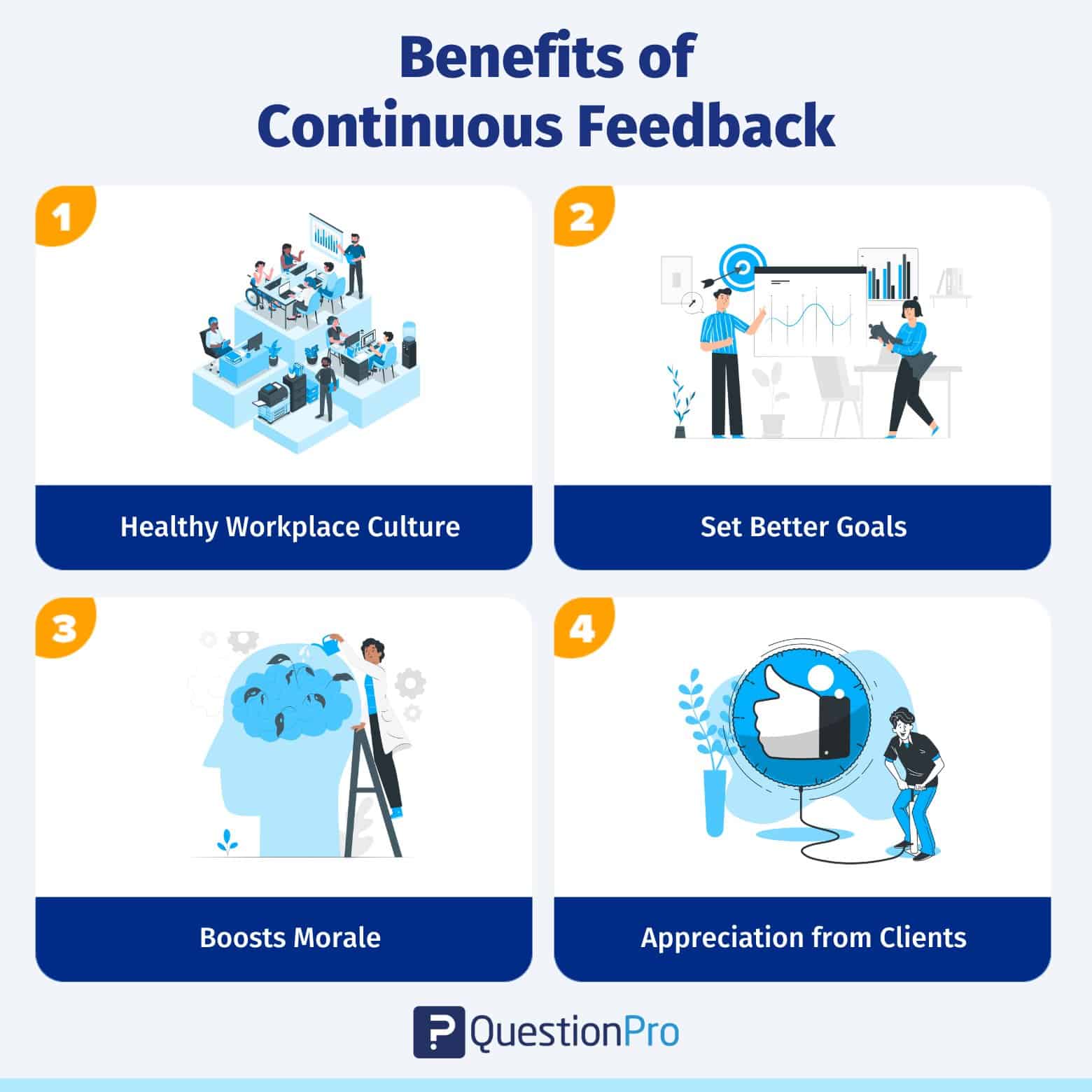
1. Helps create a healthy workplace culture:
It is important that the employees are willing to discuss their strengths and weaknesses on a regular basis. This facilitates a culture of continuous learning and development within the organization. Implementing continuous feedback will help employees excel in the workplace.
2. Helps employees and organization set better goals:
Organizations that set quarterly goals tend to generate 30-35% better results than organizations that set annual review goals. Feedback to employees and vice versa helps set achievable goals.
3. Boosts morale:
Providing the ability to your employees to give feedback not only boosts their morale, they feel a personal responsibility towards the organization. When employees feel heard, they feel confident that their feedback is being implemented.
4. Appreciation from clients:
Continuous feedback should not be restricted to only internal improvement, but clients and customers should also be allowed to give continuous feedback so that the organization keeps improving. If any changes in the systems or processes directly affect the clients, feedback can be taken from them before implementing them.
Learn more: Employee Net Promoter Score (eNPS)
Continuous Feedback Software and Tools – QuestionPro’s Pulse Review App
Why give feedback to your employees once a year when you can do it anytime, anywhere, with the QuestionPro Pulse Review app? This slick app is loaded with features that enable a manager/supervisor to perform reviews in real-time. With the Pulse review app, you can perform reviews in under 3 minutes!
With our expert-designed competency frameworks and color-coded attributes to describe respective performances, you can easily generate an instant report on your dashboard. Save the exhausting efforts, valuable time, and overwhelming frustration by using QuestionPro’s pulse review app today!
Write to us at workforce@questionpro.com with the subject line “Pulse Review,” and we will be happy to get you started with the continuous feedback software.





